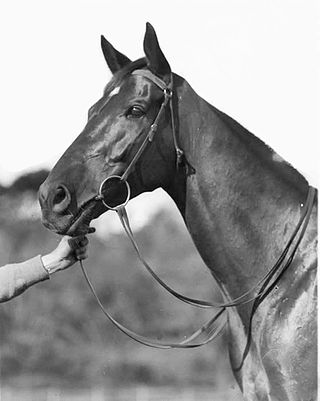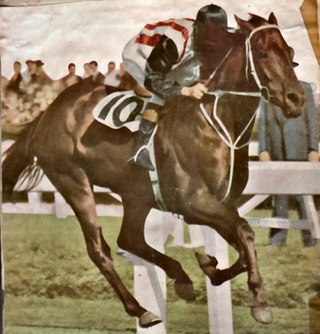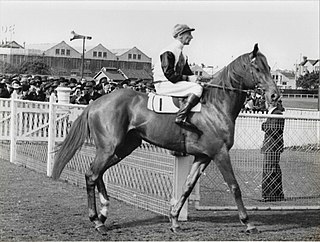
Phar Lap was a New Zealand-born champion Australian Thoroughbred racehorse. Achieving incredible success during his distinguished career, his initial underdog status gave people hope during the early years of the Great Depression. He won the Melbourne Cup, two Cox Plates, the Australian Derby, and 19 other weight-for-age races.

Thoroughbred horse racing is a spectator sport in Australia, and gambling on horse races is a very popular pastime with A$14.3 billion wagered in 2009/10 with bookmakers and the Totalisator Agency Board (TAB). The two forms of Thoroughbred horseracing in Australia are flat racing, and races over fences or hurdles in Victoria and South Australia. Thoroughbred racing is the third most attended spectator sport in Australia, behind Australian rules football and rugby league, with almost two million admissions to 360 registered racecourses throughout Australia in 2009/10. Horseracing commenced soon after European settlement, and is now well-appointed with automatic totalizators, starting gates and photo finish cameras on nearly all Australian racecourses.

The W. S. Cox Plate is a Group 1 Thoroughbred horse race for horses aged three years old and over under Weight for age conditions, over a distance of 2040 metres, that is held by the Moonee Valley Racing Club at Moonee Valley Racecourse, Melbourne, Australia in late October. The race has a purse of A$5,000,000.

Carbine (1885–1914) was a champion New Zealand-bred Thoroughbred racehorse who won 30 principal races in New Zealand and Australia. He was very popular with racing fans, and sporting commentators of the day praised him for his gameness, versatility, stamina and weight-carrying ability, as well as for his speed. He was one of five inaugural inductees into both the New Zealand Racing Hall of Fame and the Australian Racing Hall of Fame.

Musket (1867–1885) was an English-bred Thoroughbred racehorse and a Leading sire in Australia and New Zealand.

Kindergarten was a New Zealand bred Thoroughbred racehorse that raced during the early 1940s. He won many of the premier events in New Zealand including the Wellington Cup and Auckland Cup for more than £16,000 in stake money, which was a large amount during the War.

Gloaming was an outstanding Thoroughbred racehorse, owned, trained, and based in New Zealand. He set many records which included the Australasian record of 19 successive wins, many in Principal Races. Gloaming was unusual in that he was a champion who won many major races in both Australia and New Zealand. Gloaming still holds the Australasian record of 45 seconds for four furlongs.

Spearmint (1903–1924) was a British Thoroughbred racehorse and a sire. In a brief racing career which lasted from 1905 until June 1906, he ran five times and won three races. After showing moderate form in 1905, he won The Derby on his seasonal debut at age three and then became the first British horse for twenty years to win France's most important race, the Grand Prix de Paris. He became a successful breeding stallion, siring major winners in Europe and the United States. His daughters produced the winners of eight classic races. Spearmint was placed on the winning sires and brood-mare sires lists on several occasions.

Nightmarch (1925−1954) was an outstanding New Zealand bred Thoroughbred racehorse known as The Kiwi. He won the New Zealand Derby and Dunedin Cup as a three-year-old before going to Australia where he became the first horse to win both the Melbourne Cup and Cox Plate in the same year, as well as other Principal races.

Flight (1940–1953) was an Australian Thoroughbred racemare that was the highest stakes winning mare in Australasia. Her courageous efforts made her a crowd favourite during the post World War II era and she had victories over some of the great horses of the time including Shannon, Bernborough, Royal Gem and Russia.
Entreaty was a black New Zealand-bred Thoroughbred mare, who was unplaced in her only race start. She produced twelve horses, one of which was the champion Phar Lap. She was foaled in 1920 out of Prayer Wheel (NZ) by Winkie (GB).

Chatham was an outstanding Australian Thoroughbred racehorse that was bred by Percy Miller at the Kia Ora Stud near Scone, New South Wales.

Amounis was an Australian Thoroughbred Hall of Fame racehorse. He won 33 races over distances ranging from 6 to 12 furlongs. Of these wins, 27 were in "Principal Races", 16 of these races have since been promoted to Group One (G1) status. In winning the AJC Epsom Handicap he established a new Australasian record time.

Grand Flaneur (1877–1900) was an outstanding Australian Thoroughbred racehorse and sire, who won nine successive races, including the AJC Derby, the Victoria Derby and the 1880 Melbourne Cup, before he retired undefeated. He had won races over distances ranging from five furlongs to three miles. He was the Leading sire in Australia in 1895 and was close to the top of the list for a decade.

Tulloch was a champion Australian Thoroughbred racehorse who was one of the greatest Australian stayers.
Hydrogen was a champion Australian thoroughbred racehorse.

Yaralla was an Australian Thoroughbred racehorse who raced for 5 seasons from a two-year-old to a six-year-old recording major wins from 5 furlongs to 1¼ miles and regular Sydney jockey being Ted McMenamin.
The 1929 Melbourne Cup was a two-mile handicap horse race which took place on Tuesday, 5 November 1929.

Radium was a British Thoroughbred racehorse. A slow maturing racehorse, his most significant wins did not occur until his four and five-year-old seasons. After retiring from racing Radium became a successful stallion, siring 2000 Guineas winner Clarissimus and the sire of Phar Lap.
















